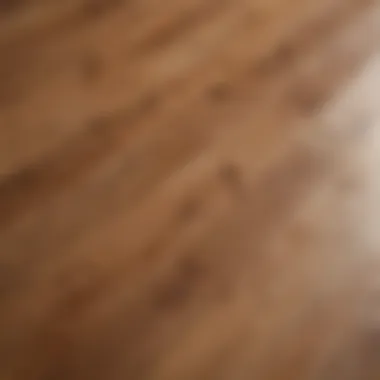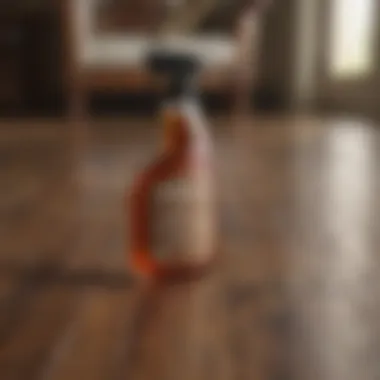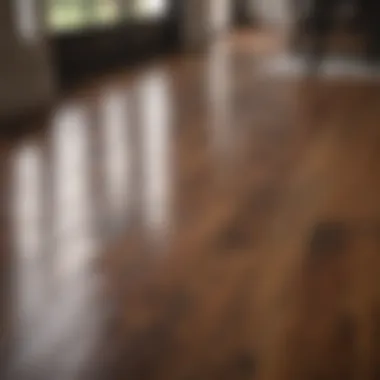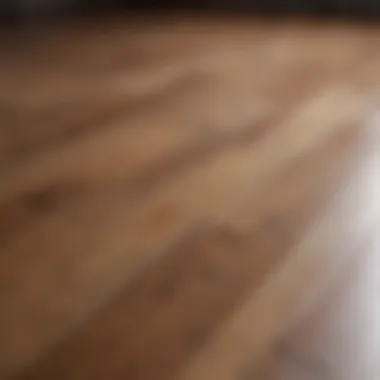Effective Techniques for Removing Stains from Wood Floors


Intro
Maintaining the elegance of wood floors can be challenging, especially when stains occur. Homeowners and interior design enthusiasts alike face this dilemma regularly, causing difficulty in preserving the beauty and integrity of these surfaces. Understanding various stain types, cleaning techniques, and preventive measures can significantly enhance the overall care of wood flooring. This guide aims to provide actionable steps along with considerations for different household scenarios, ensuring that you can handle any stain with confidence.
Interior Design Tips
Maintaining aesthetic appeal while managing stains is essential in interior design. Wood floors add warmth and sophistication to any space. However, they need careful consideration regarding cleaning and upkeep. Here are some tips for the home:
Practical Surface Cleaning
- Always consider using cleaning solutions specifically designed for wood. Effective products prevent damage while ensuring cleanliness.
- For watery stains, absorb spills immediately using a soft cloth to avoid longer-lasting marks.
- Dried stains may require gentle abrasives. Rather than heavy-duty scrubbing, a light approach with selecting materials helps ensure the floor remains unharmed.
Protecting From Stains
- Area rugs can protect high-traffic areas of wood floors. Placing rugs beneath furniture equals a smart design choice that can minimize future stains.
- Water dishes for pets and plants should be positioned thoughtfully to avoid significant damage from spills.
Understanding Wood Floors and Stains
Understanding wood floors, their characteristics, and the types of stains they encounter is critical for any homeowner or interior design enthusiast. Wood floors offer a warm and inviting atmosphere in a house, but they require specific care to maintain their beauty. Stains can quickly mar this aesthetic, diminishing the overall appeal. Therefore, it becomes essential to grasp some foundational knowledge about wood flooring materials as well as the sources of common stains.
Overview of Wood Floor Types
Wood floors come in various types, each exhibiting unique traits and susceptibility to stains. The most common classifications are solid hardwood, engineered hardwood, and laminate.
Solid hardwood flooring is milled from single pieces of timber, providing great durability and longevity. However, it can be more vulnerable to moisture, resulting in risks such as warping or staining.
Engineered hardwood consists of multiple layers with a thick veneer of real wood on top. This type is more resistant to humidity, making it a popular choice in areas prone to moisture. Lastly, laminate flooring mimics the appearance of wood, is highly durable, and is relatively less expensive. However, it is not made of real wood, which can affect restorative efforts regarding stains.
Understanding these differences will allow homeowners to apply the appropriate cleaning methods specific to the flooring type and tackle stains more effectively.
Common Causes of Stains
Stains can arise from many sources. Identifying the origin of the stain is vital to determine the most effective removal strategy. Here are some common culprits:
- Liquid spills: Water, coffee, or wine can leave behind significant marks, especially if not addressed promptly.
- Foot traffic: Dirt and debris trapped on shoes can profitably contribute to dark scuff marks on wood flooring.
- Household products: Certain cleaning chemicals may react with the finish of the floor, leading to discoloration.
- Pets and wildlife: Pets can introduce their unique set of stains, from muddy paws to accidents on the floor. Each context implies that understanding the causes is crucial for developing a targeted cleaning approach, ensuring effective stain management and maintenance of your cherished wood floors.
Identifying the Type of Stain
Identifying the type of stain on wood floors is a fundamental step in effective stain removal. Knowing the source of the stain allows for targeted cleanup and the use of suitable cleaning methods. Factors like the age of the stain and the broader effects on the wood can critically influence the outcome. Homeowners should understand that different types of stains demand different approaches. This awareness not only mitigates further damage but also extends the life of wood flooring products.
Water Stains and Their Impact
Water stains appear as unsightly markings, often light or dark. They can develop when liquids remain on the wood's surface for a period. Depending on the type of wood and its finish, some floors may absorb moisture, resulting in either discoloration or warping. The impact varies; immediate attention can mean the difference between a quick clean-up or significant repair.
To treat water stains, first, identify if the stain is still wet or has dried. For fresh stains, carefully blot the area with soft cloths. For dried water stains, consider light sanding or appropriate cleaning solutions that may restore the surface appearance.
Oil or Grease Stains
Oil and grease stains often originate from cooking, neglecting to clean common spills. These stains tend to cling firmly to the wood, making removal challenging. If left unaddressed, they can attract dust and become a more substantial issue over time. Understanding the type of wood floor is critical here, as some finishes might not tolerate aggressive solutions.
When dealing with these stains, a gentle warm soap-water solution often works. However, using mineral spirits can be effective for stubborn grease. Test any cleaner in an inconspicuous spot first to ensure compatibility with the finish.
Food and Beverage Stains
Food and beverage stains are frequent culprits in many homes. They derive from spills, careless eating, or casual gatherings. The various colors can emerge from different types of food and drink, creating a range of challenges for cleaning. It’s advisable to address these stains promptly to prevent them from adhering securely to the wood grain.
For cleaning, options include a solution of mild soap or even certain commercial wood floor cleaners approved for your use. Making everyday habits could also stem from keeping area rugs in dining spots. Constant prevention is always preferable than prioritizing post-spill clean-ups.
Ink and Dye Stains
Ink and dye from art materials, newspapers, or colored paper can pose serious challenges for wooden floors. These stains can penetrate deeply and are often resistant to typical cleaning agents. The effect on wood is frequently long-term, resulting in lasting discoloration if not managed promptly.


When treating these stains, it's best to act without harsh scrubbing, which can damage the wood. Try gently blotting with a clean cloth and mild soap until the dye starts to lift, and if that falls short, a solvent like rubbing alcohol may be used cropped with soft application.
In all these situations, knowing the type of stain will guide toward the best methods to remedy the situation. By acting decisively and employing the correct techniques, homeowners can maintain their wood floors’ beauty and longevity.
Initial Cleaning Techniques
Initial cleaning techniques are crucial for preserving the beauty of wood floors and minimizing long-term damage from stains. A timely and effective response not only helps in removing the stains but also prevents them from settling deeper into the wood grain. Successful initial cleaning techniques can significant impact the overall appearance and lifespan of the flooring.
Immediate Response to Spills
An essential tactic in maintaining wood floors involves prompt action when spills occur. When a liquid like water or juice lands on the floor, its immediate collection is key. Identify the spill and use a soft cloth or paper towel to soak up as much liquid as possible. The objective is to minimize contact time between the stain and wood material.
Make sure to dab the area gently. Rubbing may cause more damage or push the liquid into the wood. After soaking up the spill, it is advisable to slightly dampen the cloth with a wood-friendly cleaning solution. This step aids in lifting any remaining liquid or stain particles. Ensure that the rag is damp and not overly wet to prevent saturation, which could worsen the situation.
Tip: Always try to test any cleaning solution in an inconspicuous area before applying it broadly, as some chemicals might adversely affect the finish of the wood.
Dusting and Regular Maintenance
Regular maintenance is vital in preventing dust accumulation, which can eventually cause unsightly scratches and dullness on wood floors. Dusting should occur frequently, ideally on a weekly basis. Using a microfiber dust mop is recommended. It captures dust and dirt effectively without scratching the surface, differing from stiff brooms.
In addition to simple dusting, consider deeper cleaning practices periodically. These may include:
- Vacuuming: Employing a vacuum with a soft brush attachment can assist in removing embedded dirt if dusting alone seems insufficient.
- Natural Cleaning Solutions: Utilizing diluted vinegar with water can maintain shine while deep cleaning. Remember to avoid oil-based finish and harsh chemicals.
Prioritizing initial cleaning techniques with diligence prevents the need for extensive remedial work later. Keeping wood floors clear of spills and debris aids their longevity and aesthetic appeal.
Homemade Solutions for Stain Removal
Homemade solutions can present effective means for addressing stains on wood floors. Utilizing these methods not only conserves household budgets but also allows homeowners to rely on ingredients often found in their homes. This creates a less toxic environment as this solutions usually avoid harsh chemicals. Simple bakery items and household substances can tackle both minor and prevalent stains, making them essential knowledge for any homeowner or interior design enthusiast.
Given the variety of potential stain causes, it is crucial to identify those that affect your specific wood conditions. This flexibility in addressing different types of stains encourages tenants and homeowners alike to alleviate blemishes with confidence while advocating for preventive strategies in care and maintenance.
Vinegar and Water Mixture
A vinegar and water mixture is reliable and efficient for stain removal in wood floors. Mixing equal parts of distilled white vinegar and water creates a solution that can lift light stains and grime. The acidic nature of vinegar acts effectively against stains, without stripping the wood’s finish.
To apply, follow these steps:
- Prepare the Solution: Combine half a cup of vinegar with half a cup of water in a spray bottle.
- Spray Lightly: Apply the solution directly onto the stained area but avoid over-saturating the wood, which can cause damage.
- Wipe with a Soft Cloth: Use a microfiber cloth to gently scrub the stain away, ensuring no liquid pools on the surface.
- Dry the Area: After cleaning, dry the area comprehensively to prevent further moisture exposure.
Considerations include avoiding vinegar on unsealed wood, as prolonged exposure to acid can deteriorate the finish. Regular modest cleaning with this mixture can enhance the luster of wood while preventing tougher situations.
Baking Soda Paste
Baking soda paste is another popular do-it-yourself option for stain removal. When mixed with a small quantity of water, baking soda creates a slightly abrasive paste that can lift stubborn stains without causing harm to wood floors.
To leverage this method effectively, follow these approaches:
- Crafting the Paste: Combine three parts baking soda to one part water to achieve a paste-like consistency.
- Apply with Care: Carefully spread this paste over the stain, taking care not to apply too aggressively to avoid scratching the wood.
- Let it Sit: Allow the paste to sit for 5-10 minutes to penetrate the stain adequately.
- Gently Wipe Off: After this duration, scrub the area lightly with a sponge or cloth.
This paste is particularly beneficial for grease or food stains. However, it is always wise to test any homemade mixture on a small inconspicuous area first. This precaution helps safeguard wood finishes against unexpected reactions.
Olive Oil and Vinegar for Minor Stains
For very light stains or scuffs, combining olive oil with vinegar can prove beneficial. This mixture serves the dual purpose of massaging the wood while also cleaning the surface.


To adopt this technique effectively, one can follow these steps:
- Create the Mixture: Mix two parts olive oil with one part vinegar in a bowl.
- Use a Soft Cloth: Dampen a clean cloth with this mixture, avoiding excess.
- Buff the Stained Area: Gently rub the blend into the wood in a circular pattern for best results.
This approach not only helps to lift minor stains but can also enhance shine while nourishing the wood. It is important not to overuse this method, as excess oil left on the surface could attract dirt and dust.
Commercial Products for Stain Removal
When tackling stubborn stains on wood floors, commercial products can be effective solutions. They often contain specialized ingredients designed to target specific types of stains, making them a valuable resource for homeowners and enthusiasts alike. Understanding the variety of cleaners available helps in selecting the appropriate one suited for your wood flooring, ensuring effective stain removal while preserving the floor's finish.
Choosing the Right Cleaner
Selecting the right cleaner is paramount to safeguarding your wood floors. Not all products are suitable for every type of wood or stain, and using an incompatible cleaner can further damage the flooring. It is important to consider the following factors when making your choice:
- Type of Stain: Identify the type of stain you are dealing with, as some products are tailored for specific stains such as inks, oils, or waters.
- Floor Finish: Check your floor's finish type- whether it is urethane, oil, or wax, as some cleaners might react negatively with certain finishes.
- Cleaning Formula: Look for formulas labeled as safe for hardwood floors, preferably those that are pH balanced to prevent dullness or residue.
- Brand Reputation: Opt for established brands like Bona, Murphy Oil Soap, or Minwax. These brands often provide reliable customer feedback.
Now, you might ask, “Where to find these products?”. Most of these cleaners are readily available at home improvement stores or online platforms such as Amazon.
Application Techniques
The way you apply the cleaner also influences effectiveness. Proper application techniques ensure that the cleaner penetrates adequately, allowing for effective stain removal while minimizing the risk of damaging your floors.
- Read Instructions: Always begin by carefully reading the label instructions on the product. Each cleaner may have specific guidance about use.
- Test Area: Always test the cleaner on a small, inconspicuous area before full application. This step helps ensure that the product does not adversely affect the floor finish or color.
- Damp Cloth: Use a damp, soft cloth for application, avoiding harsh scrubbing, which could scratch the surface.
- Follow-up Clean: After applying the cleaner, it is essential to follow up with water or a designated wood floor cleaner to ensure no residue remains.
Using the right product and application technique can dramatically change your wood floor’s appearance and longevity.
Advanced Techniques for Stubborn Stains
Dealing with persistent stains on wood floors requires specialized methods to restore their natural beauty. Highlighting robust techniques helps homeowners understand how to address serious staining issues that typical cleaning merely cannot resolve. Knowing when and how to use advanced techniques ensures the longevity and appearance of your wood flooring.
Sanding and Refinishing
Sanding is a crucial technique to consider when dealing with deep-set stains. It removes the top layer of the wood, effectively shredding away both stains and surface blemishes. This technique is particularly apt for removing unwanted marks or discoloration caused by heavy footprints or spilled substances that penetrated the top surface. The sanding process involves using multiple grits of sandpaper, starting from coarse to medium and then fine, ensuring a smooth and even surface.
One must recognize that sanding changes the thickness of wood. The clearer the wood surface exposed, the neater the finish. It is often advisable to consider pre-sanding inspections. Before sanding, it is wise to ventiate the room to reduce dust concentrations. Sand publically requires skills, so hiring a professional can mitigate the risks involved.
Another consideration is refinishing. Once the floor is sanded, applying a proper sealant like polyurethane is essential. This enhances the gloss and protects the newly prepared floor from future stains. Make sure to choose the finish suitable for particular wood types, as this also contributes to the overall look and performance.
Pros of Sanding and Refinishing
- Extensive stain removal: Highly effective against deeply rooted stains.
- Restoration: Breathe new life into old or tired floor finishes.
- Preparation for future maintenance: Creating a fresh surface to resist new future stains.
Cons of Sanding and Refinishing
- Labor-intensive: This job can be physically demanding and time-consuming.
- Initial cost: Upfront expenses may be high if hiring a professional for the job.
- Room accessibility: The area affected during the process may not be usable until completion.
Maintaining a regular schedule for inspections could help identify when this technique should be used.
Using Oxalic Acid for Deep Stains
Oxalic acid serves as a very effective treatment for more stubborn, darker stains, most commonly found in wood that has developed mold or relating to mineral deposits. This method dives deeper compared to standard surface cleaning techniques, dissolving tough discoloration that other methods might overlook. Adjusting to its correct concentration is essential. A solution between 5% to 10% is generally strong enough for household use.
Using oxalic acid successfully involves mixing the acid with warm water to create a potent solution. When applying the solution, consider the use of protective gear, including gloves and a mask, being as avoidance inclusion of these can lead to irritation.
After applying oxalic acid, let it lighten the wood for specified time—commonly fifteen to twenty minutes—and then wipe off the excess with clean water. It is wise to cleanse thoroughly, as well unnoticed residues might lead finishing complications when refinishing.


Preventing Future Stains
Preventive measures are crucial in maintaining the appearance and integrity of wood floors. When homeowners prioritize stain prevention, they can significantly reduce cleaning efforts and prolong the life of their wood flooring. A proactive approach not only protects the wood but also enhances the aesthetics of a living space.
Understanding the common sources of stains can guide homeowners in implementing effective prevention strategies.
Guaranteed benefits of taking preventive action include:
- Cost savings on potential repairs and extensive cleaning products.
- Extended lifespan of the wood flooring.
- Consistent and appealing interior aesthetics without visible blotches or discoloration.
By keeping potential stains at bay, it sets the foundation for a manageable cleaning routine while preserving the overall allure of the space.
Regular Maintenance Practices
Maintaining clean wood floors regularly can stave off stubborn stains. Implementing a routine cleaning schedule is essential. For most homes, weekly or bi-weekly cleaning might suffice. Dust and dirt can accumulate quickly, acting like abrasives when walked on, leading to potential scratches and scuffs. Thus, here are effective practices for regular maintenance:
- Dust promptly: Always sweep or vacuum the floor to remove dirt particles.
- Use a damp mop: An ordinary mop with too much water is harmful. Instead, use a damp mop in line with the product recommendation and clean only as necessary.
- Spot-clean: As spills occur, it’s paramount to address them immediately with the appropriate cleaning solution to minimize damage.
In filtered light, small scratches may be prone to fogging and may show more with time. Regular cleaning prevents not just stains, but lingering imperfections as they may get worse.
Homeowners might consider using a specific cleaner for wood, ensuring the product is pH-balanced. Over-the-counter options like Bona and Murphy’s Oil Soap can serve well, but always check compatibility with your floor type.
Protective Measures for High-Traffic Areas
High-traffic areas within the home are vulnerable spaces that require significant attention to stain prevention.
Here are some suggestions to provide protection in those zones:
- Area rugs: Strategically place rugs in entryways and under furniture to absorb footsteps and collect dirt before it can embed into the wood.
- Matting at entrances: Use matting at the entrance, as they collect excess moisture and dirt before it can spread across the floor.
- Furniture pads: Installing furniture pads on the bottom of chair legs can vastly reduce scratches from dragging or movement. They can help in fluid outlays while preserving the look of the floors.
- No wet shoes: Enforce the habit of removing wet or muddy shoes before entering the house, effectively cutting the source of moisture and dirt.
It’s always easier to prevent stains than to deal with them.
Combining these habits creates a robust defense against common staining agents. Diligence in initiating these preventative measures retains the rich quality of wooden floors and preserves their appearance over the long term.
Final Thoughts on Stain Management
The final thoughts on stain management highlight the essential practices for preserving the quality and appearance of wood floors. Understanding the complexities involved in managing stains can significantly benefit homeowners and design enthusiasts. Addressing initial reactions to spills, choosing suitable cleaning techniques, and implementing proactive maintenance measures are key elements in effective stain management.
Proper stain management is not just about immediate reactions; it extends into long-term care. Regular attention to wood floors can mitigate potential damage and maintain their visual appeal. Taking time to understand different cleaning products and methods also increases efficacy. Thus, the goals of stain prevention blend with practical action further into homeowners’ daily routines.
Evaluating Long-Term Care Options
When it comes to maintaining wood floors, evaluating long-term care options becomes crucial. Homeowners should consider the type of finishes used on their floors, as this dictates how stains respond both to cleaning efforts and to preventive measures. Certain finishes might require more sensitive care strategies, while others may withstand a wider array of cleaning techniques.
Staying updated about innovations in wood floor care products can provide better alternatives to maintain floors. Companies such as Bona and Murphy Oil Soap regularly release options that promise distinct benefits. Moreover, some products are eco-friendly, providing both stain management and preservation of indoor air quality. Homeowners can greatly benefit by balancing effectiveness and environmental responsibility.
Daily habits are an important aspect. Regular cleaning utilizing soft, non-abrasive materials helps ensure easier maintenance without ground-in stains over time. Vacuuming consistently and immediate attention to spills can mean less intense cleaning is needed later.
Consider these effective long-term options:
- Regularly schedule professional cleaning: Using professionals can provide deeper reach into hard-to-clean areas, minimizing long-term stains.
- Invest in professional refinishing services every few years: This will upkeep the aesthetic quality of wood floors while protecting slabs from the deep penetration of stains.
- Create controlled environments: Use area rugs in prone zones to mitigate risks knowing which spots typically attract spills or moisture.
Consulting Professionals
Consulting professionals is an advisable option for comprehensive solutions in stain management. Their experience often provides unparalleled benefits.
If stains become insistent or challenge simple removal techniques, experts can offer advanced treatments. They're trained to decipher the intricacies of wood finishes and raw materials, which aids in decision-making about further care options. A qualified floor technician can not only deal with existing stains but also make recommendations for restoration or refinishing practices.
Additionally, consultation can prepare homeowners with implementation of preventive strategies. A professional can evaluate the specific conditions of your home and ways to apply sufficient engagement over time. Through this guidance, individuals can best determine what routine maintenance might entail moving forward.
With the correct knowledge and assistance, wood floor stain management prevents more severe damage, thereby enhancing both longevity and immediate appearance.
In the matter of upkeep and restoration services, no harm is derived from engaging experts to impart their wisdom. After all, a cohesive approach combines information and evolving best practices to optimize the display and utility of beautiful wood floors.







